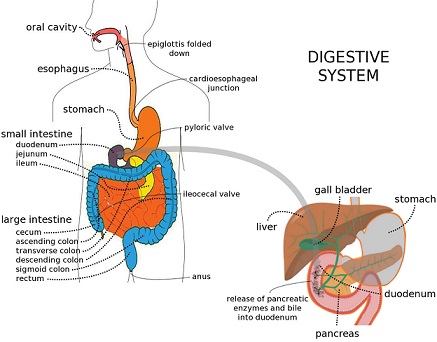The function of the digestive system is to break down larger food compounds down to nutrients that can be absorbed in the intestine and assimilated into cells. Digestion starts in the mouth where mechanical and chemical breakdown of food particles occurs, then the bolus travels down the esophagus by the wave-like action of peristalsis. The bolus enters the stomach where it is mixed with gastric juices, secretions and digestive enzymes to be churned for 1-2 hours. The remaining liquid, called chyme, enters the small intestine where products are absorbed through the villi and microvilli on the surface walls. The large intestine is where water absorption takes place, and the remaining product is excreted from the anus. This overview process can be seen in the diagram of the digestive system:

Image Credit: Wikimedia Commons.
Enzymes play a key role in digestion, they catalyze biochemical reactions to break down larger compounds to small constituents. Different organs along the digestive tract have varying pH levels to produce optimal conditions for specific proteins. Most enzymes involved in the digestive system have an optimal temperature of 37⁰C degrees, akin to body temperature. In the mouth, salivary amylase works upon carbohydrates to break it down to monosaccharides with and optimal pH of 6.7-7.0. In the stomach, three enzymes for the catalysis of proteins to amino acids are: pepsin, trypsin and chymotrypsin – these have optimal pH of 2. After the stomach, the pancreas releases bile which mixes with the chyme to increase its pH level to 6 – optimal for lipases to digest fats to fatty acid and triglycerides in the small intestine.
Hormones are also important in the digestive tract to mediate digestion rate, either by increasing or decreasing certain activities. An example is Gastin, it causes the stomach walls to produce pepsinogen, this enzyme is activated by coming into contact with hydrochloric acid to produce pepsin, a protease.
Title Image Credit: Wikimedia Commons
© BrainMass Inc. brainmass.com July 26, 2024, 8:15 pm ad1c9bdddf